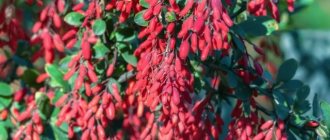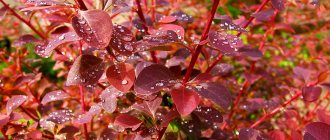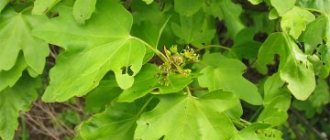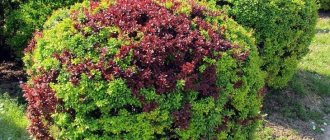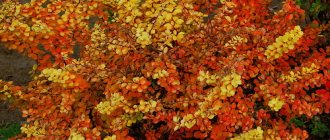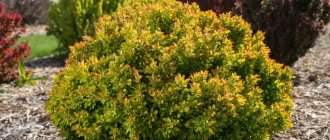Barberries are juicy scarlet and purple-red oblong berries. We know them for their unique spicy aroma and pleasant sweet and sour taste.
Barberry is a shrub plant that grows primarily in mountainous areas. It is widely used in cooking. Barberry berries have found a response in folk medicine, cosmetology, aromatherapy, and perfumery. That's how widespread the use of these berries is in areas of life. Of course, there is a completely logical explanation for such demand. The properties of barberry berries are very diverse and mostly positive.
general characteristics
These are mainly semi-evergreen (partially deciduous) plants with branches growing at an acute angle. Barberry is very light-loving, but cannot grow in wetlands - too much moisture harms it.
Despite its unremarkable appearance, this is one of the most useful plants that nature has given us. In some regions, barberry has a different name - it is called the caramel tree.
Content:
- general characteristics
- The nutritional value
- How to store barberry
- Use in cooking
- Use in medicine
- Barberry recipes
- Application in cosmetology
- Restrictions on taking barberry
Our ancestors knew very well about the medicinal properties of barberry - as early as 4 thousand years BC it was used in Egypt as a means of stopping blood. Indians used it for the same purposes, and Tibetan monks believed that regular consumption of barberry prolongs life. The Romans and Greeks planted barberry in their gardens to attract capricious luck and, of course, used it as medicine. The Chinese made an alcohol tincture to help a person with internal bleeding, and in the USA, barberry is used as an aid for diseases of the biliary system.
Edible species
No home garden is complete without fruit trees. Even the laziest gardeners plant their plots with raspberries, apple trees, and pears, but few people prefer such an unpretentious plant as barberry. In addition to its nutritional value, it is also worth noting its healing and decorative properties.
Common barberry
The most common barberry is in the Caucasus and Southern Europe, but it can also grow in Siberia. Shrubs of this species are frost-resistant and can withstand temperatures down to -35 degrees. The main condition for growing is to place the plants in sunny and dry areas. Planting in the shade negatively affects the taste and quantity of fruits.
Common barberry is one of the most common members of the family, which is distinguished by its unpretentiousness and high frost resistance.
The common barberry has quite a few varieties, namely:
- Lutea is a bush up to 2 m high with yellow shoots and light green foliage. The fruits are golden yellow and sour. It should be planted only in open sunny areas of the garden.
- Aureomarginata - can reach a height of 3 m, has very beautiful leaves, edged with a golden stripe. Very effective in hedges. The fruits are scarlet, tasty, sweet and sour, ripen in October.
The barberry Aureomarginata, whose leaves are edged with a thin golden stripe, is perfect for a decorative hedge.
- Atropurpurea - the height of the bush does not exceed 2 m, the shoots are purple with dark red leaves and fruits. A very impressive plant. Berry picking is carried out at the end of September - beginning of October.
Barberry Atropurpurea with a reddish tint of leaves is often used in landscaping urban recreation areas
- Alba variegata - this variety is valued for its high decorative properties. Its foliage is “painted” with white streaks, the color of the fruits is creamy white.
- Dulchiz - has all the species characteristics of the common barberry, and is distinguished by the high taste qualities of the fruit. The berries are sweet and fully ripen by mid-October.
- Asperma is a tall bush with red seedless berries.
Barberry syrup recipe. To prepare, you need to mash the berries with water, then squeeze out the juice. After this, the liquid must be brought to a boil, passed through a filter and added granulated sugar.
Video: characteristics and beneficial properties of barberry
Amur barberry
Plants of this species are shrubs reaching a height of up to 3.5 m. The shoots have spines up to 2 cm long. Depending on the time of year, the color of the leaves may change, acquiring a reddish tint in the fall. In spring, small yellow flowers appear on the bushes with a pleasant aroma. In November, the flowers are replaced by bright red fruits.
Amur barberry is distinguished by abundant flowering and fruiting
There are two best known varieties of this species:
- Japonica - characterized by more rounded leaves and a small number of flowers on the racemes.
- Orpheus is a non-flowering variety bred by Russian breeders exclusively for decorative purposes. The height of the bush is 1 m.
Barberry spherical
This type of barberry grows in Central Asia, Mongolia and China. It is its fruits that are included in traditional Asian dishes such as lagman, shurpa and pilaf. The shrub can reach up to two meters in height. The shiny reddish shoots are covered in showy dark green leaves in spring. The yellow-orange inflorescences bloom in early June and have a distinct aroma. The fruits are painted black, covered with a bluish coating on top.
The spherical barberry is not very adapted to the climatic conditions of Russia. If you decide to plant this shrub in your garden, make sure you have good shelter.
The fruits of the spherical barberry have excellent taste.
The ripening time of barberry fruits depends on its type. The harvest is usually harvested from September to early November.
The nutritional value
Barberry uses not only berries, but also leaves, roots and even the bark of this amazing plant. A yellow dye of natural origin is made from the bark, and the leaves can be eaten - they contain beneficial malic and citric acids, vitamins C and. The root saves from frequent bleeding, and the berries promote the excretion of bile and support liver health.
Barberry rightfully occupies an important place among dietary products due to its minimal calorie content.
100 g of product contains only 29.5 kcal.
At the same time, berry jelly already contains 218 Kcal, so it can hardly be called dietary. Nutrient content per 100 g of fresh product
| Squirrels | 1 g |
| Fats | 0 g |
| Carbohydrates | 9.5 g |
| Ash | 0.7 g |
| Water | 85 g |
What is the plant useful for?
The healing power of barberry is difficult to overestimate. It is known that it was used in Ancient Greece. The drug from it purified the blood. Tibetan monks considered it the elixir of youth.
Nowadays, all kinds of tinctures and decoctions of berries, leaves and roots are taken for treatment:
- colds (they are antipyretic and antimicrobial agents);
- successfully remove toxins from the body;
- promote blood clotting;
- cope with uterine bleeding;
- the presence of the alkaloid berberine allows it to have a choleretic effect in cholecystitis (it is effective even in the fight against a serious illness - hepatitis);
- help with inflammation of the genitourinary system (cystitis and pyelonephritis);
- for gastrointestinal diseases;
- as a blood pressure regulator;
- inhibits the growth of malignant tumors.
How to store barberry
There are several ways to store barberry berries, and the most common of them is dry storage. These are the berries that can be bought in the store at any time of the year, because dried barberries can be stored in suitable conditions for up to 2 years.
If you pick the berries yourself, you can make jam from them by mixing them with sugar in a 1:1 ratio. The original storage recipe involves pickling the berries - to do this, add 200 g of salt to each liter of water and store the resulting pickles in the refrigerator or cellar.
2.Description
Barberry is an ornamental, dense, deciduous or evergreen, thorny shrub with numerous arched branches that grows from 60 cm to 2.5 m in height.
When grown in mild climates, some varieties may remain evergreen, while the same plants may lose their foliage completely when frost hits.
The branches are brown, brown, deeply grooved, sometimes zigzag, prickly.
The leaves are small (1.2 - 4 cm long), oval or wedge-shaped, green, bluish-green, dark red or purple.
Barberry blooms from mid-April to May. Pale yellow flowers about 0.6 cm in diameter are collected in inflorescences - umbrellas, each with 2 - 4 flowers. The inflorescences are located evenly along the entire length of the stem.
The fruits are bright red, spherical or elliptical berries about 1 cm in length, ripen in late summer - autumn and remain on the bush during the winter. In autumn, barberry leaves turn bright shades of red and orange. In winter the leaves fall.
Height . Up to 2.5 m.
Use in cooking
The berries are used to make sweets - they are used to make compotes, jams or preserves, and are also often used for jellies. Dried and crushed barberry will be an excellent sour seasoning that will add an original taste to your dishes. The berries can also be used to make tasty wine or liqueur. But for pickling, it is better to use slightly unripe berries - this way they do not acquire sweetness, which will spoil the taste of the pickle.
Choose berries for pickling very carefully, because too unripe fruits contain toxic substances.
Treatment with barberry
Barberry is considered an excellent remedy for combating many diseases. Decoctions and infusions of both berries and roots and leaves are used.
Decoction
To make a decoction from the leaves or bark of this plant, take 1 tbsp. dry mixture and add 250 ml of water, and then boil quickly. Next, you need to wait until the broth is infused for half an hour and, after cooling, strain thoroughly. Using cheesecloth or a fine sieve to remove impurities.
Chopped barberry roots are made as follows: 2 tbsp. Pour the plants with 2 glasses of water and, like the leaves, quickly boil. You need to leave them for an hour, then strain after cooling.
Tincture
A tincture is usually made from the leaves. Take dried crushed leaves, pour a glass of vodka or diluted alcohol and leave for 7-10 days in a cool, dark place.
Chemical composition
It’s not just berries that have healing qualities.
The plant leaves, bark and roots have a diverse chemical composition. The fruits can be safely called a storehouse of vitamins A, C, E, K. They are rich in:
- pectins;
- beta-carotene;
- natural sugars;
- carotenoids (lutein, capsanthin, auroxanthin);
- organic acids (malic, citric, tartaric).
The bark and rhizome contain alkaloids (berberine, palmitine, iatroricin) and tannins. Such diversity has made barberry a medicinal raw material for medical preparations.
Use in medicine
A decoction of the roots is used for:
- excessive production of bile;
- inflammation.
It is recommended to drink a decoction of the leaves for:
- hepatitis;
- pregnant women with constant vomiting;
- liver diseases;
- inflammation of the gallbladder;
- digestive disorders;
- inflammation of the gastrointestinal tract;
- diarrhea;
- ulcers;
- bleeding in the gastrointestinal tract;
- dysentery;
- diseases of the bile ducts.
An infusion of leaves is used for:
- jaundice;
- digestive disorders;
- inflammation of the gastrointestinal tract;
- diarrhea;
- ulcers;
- bleeding in the gastrointestinal tract;
- dysentery.
Juice and fresh berries are taken for:
- decreased activity of the nervous system;
- poor emotional state;
- as tumor prevention;
- at high temperature.
A decoction of the bark is used for:
- inflammation of the pancreas;
- high blood pressure;
- problems with the heart;
- as a diuretic;
- as an antipyretic for various diseases, including pneumonia and tuberculosis.
Berries are used for:
- poor appetite;
- constipation;
- ulcer or hemorrhoids;
- with radioactive exposure.
It is also good to use a decoction of barberry roots for gynecological diseases and inflammation as baths or for douching. They are also used for inflammation in the mouth as a rinse.
To combat diseases of the skin or eyes, lotions are used, and for problems with bones and blood vessels - as rubbing or compresses.
For gynecological diseases
An infusion of barberry leaves perfectly fights gynecological diseases, especially those that cause heavy bleeding. You can make this decoction directly in a thermos so that it can infuse better. To combat gynecological diseases, you should drink 70 ml several times a day (up to 6 times) after meals.
For pancreatitis
Barberry is also effective in treating pancreatitis or reducing symptoms of a chronic disease. It is best to use it in a mixture with licorice in a 2:1 ratio. Pour in enough water (half a liter for 3 tablespoons of the mixture), leave for 8-12 hours, and then boil over low heat. You need to drink 150 ml 3 times a day after meals.
Other uses
Few people now remember that barberry berries in their pure form (fresh) are a good help for hangovers or prolonged libations, including for the treatment of binge drinking.
Fresh berries are great for those with heart problems - just eat them every day as a dessert and you will feel much better!
3.Barberry - planting and care in open ground
Planting in open ground is carried out both in the autumn months and in the spring , preferably in the evening hours.
If planting is carried out in the fall, then the plants should have time to take root well in the new place before the onset of serious frosts.
Spring planting is carried out in early spring - before the leaves appear .
A well-lit or semi-shaded place without surface groundwater is suitable for growing barberry. Since the shrub easily withstands even strong gusts of wind, you can choose an open area for it.
For keeping in open ground, specimens 2-3 years .
The area for barberry is dug up and the weeds are removed. If the soil is too acidic, then first sprinkle the soil with slaked lime or spill it with milk of lime. Too heavy, clayey soils that can retain moisture should be further loosened by adding a sufficient amount of river sand.
↑ Up,
The planting scheme will depend on the varietal characteristics (plant height), as well as on the desired result. If you plan to plant single bushes, then a distance of 1.5 - 2 m , and when grown as a hedge, the plants are placed at a distance of 20 - 70 cm . - in one, two or even three rows.
You can also place bushes in a checkerboard pattern .
For planting, prepare holes about 40 cm wide and deep a drainage layer in the form of fine gravel or expanded clay 7-8 cm thick is placed
Nutritious soil with a high content of organic matter in the form of humus, well-rotted manure or with the addition of mineral fertilizers - for example superphosphate - is poured onto the drainage
The bushes are placed in the center of the hole and sprinkled with earth in a circle.
↑ Up,
After planting, the soil around the barberry is thoroughly compacted and the bush is watered with plenty of water.
It is advisable to mulch the base of the plant with mown grass , sawdust or fallen leaves. A layer of mulch will protect the soil from too rapid evaporation of moisture and retard the development of weeds.
After planting in the ground, the ground part is cut off , leaving only strong shoots with 3 - 5 buds on each.
Only transplanted plants will need regular watering , but over time the barberry will become less demanding and will easily tolerate slight drought.
Ongoing care for these plants will include weeding, pruning, fertilizing and loosening the soil.
↑ Up,
3.1.Wintering
The real test for young plants in the middle zone will be their first winter outside. For 2 - 3 years after planting in open ground, the shrub should be covered for the winter with a layer of fallen leaves, spruce branches or non-woven material.
Evergreen plants are less frost-resistant.
Tall plants are wrapped in non-woven material to their full height . Mature bushes over 5 years can tolerate frosts without additional shelter .
Barberries are opened in the spring, as soon as the snow melts on the site. After it becomes clear which branches survived the winter well and which suffered from frost, carry out sanitary pruning , removing all weak and dead branches.
↑ Up,
Barberry recipes
Barberry berries are used for many recipes, mainly for healthy and tasty sweets. We will share several recipes.
Jam
Fresh berries need to be poured with warm water and then left for several hours - it is better to leave overnight. Then you need to drain the water into a separate container, add sugar (1.5 times more than there were berries), add barberries and cook for half an hour. You need a little water - 500-700 ml of water is enough for 1 kg of berries. As a result, you will get jam with a pleasant sour taste.
Juice
To get the maximum juice from barberry, place the berries in boiling water, hold for a couple of minutes, then drain the water and pass the berries through a juicer.
Jelly
Take a pan (preferably enameled), add berries there, fill with water in a ratio of 1:4 and set to cook. Wait until the berries are warm enough to soften, then you need to grind them and add the same amount of sugar as you had berries. Then boil thoroughly and pour into sterile jars.
Application in cosmetology
Barberry berries are used to preserve youth and beauty. For this purpose, decoctions or infusions are made from them, which are used for masks, rubbing or as a rinse balm. Barberry perfectly strengthens hair, helps fight fine wrinkles and skin blemishes, eliminates dandruff and is simply used to maintain skin tone.
Hair balm
To make this simple and effective hair conditioner, you only need a handful of barberry. Pour a liter of boiling water over the dried berries, then cover with a thick cloth and leave to infuse in a warm place. Then the infusion needs to be strained to remove small impurities that can get stuck in the hair and cause a lot of trouble. Carefully pass the infusion through a filter or several layers of gauze - and it is ready to use!
Every time after washing your hair, rinse your hair with the resulting infusion, and over a 2-month course of treatment you will notice a difference - your hair will become more manageable, silky, dandruff will disappear, and your scalp will become healthier.
Mask for the face
A barberry mask works best when combined with several other beneficial ingredients. To prepare it, take:
- small apple;
- 4 tbsp. ground dried barberry;
- 1 tbsp. flour for thickness;
- 1 tbsp. sour cream.
All ingredients must be mixed well, applied to the face and left for 15 minutes. It is best to wash it off with brewed green tea or chamomile infusion.
Harm and contraindications
Despite a number of proven healing properties, if consumed in excess or with individual characteristics of the body, barberry can cause harm.
Side effects include:
- Complications of pregnancy. Barberry is strictly contraindicated for women during pregnancy. The components of the plant stimulate the activity of the muscles of the uterus and can cause miscarriage (in the early stages) or premature detachment of a normally located placenta (in the last weeks of pregnancy).
- Dyspeptic disorders. Typically manifests as vomiting or diarrhea.
- Transient renal dysfunction. When barberry is consumed in unreasonable amounts, the urine turns red (due to the presence of blood).
- Exacerbation of chronic diseases of the gastrointestinal tract (gastritis, enteritis, peptic ulcer) . The berry has a pronounced irritant effect on the mucous membranes.
- Allergic reactions . The scientific literature has not described a single case of allergy to barberry, however, this does not exclude the possibility of its development.
You should be careful when including barberry in your diet due to the presence of contraindications and adverse reactions. The plant should not be taken during pregnancy at any stage.
